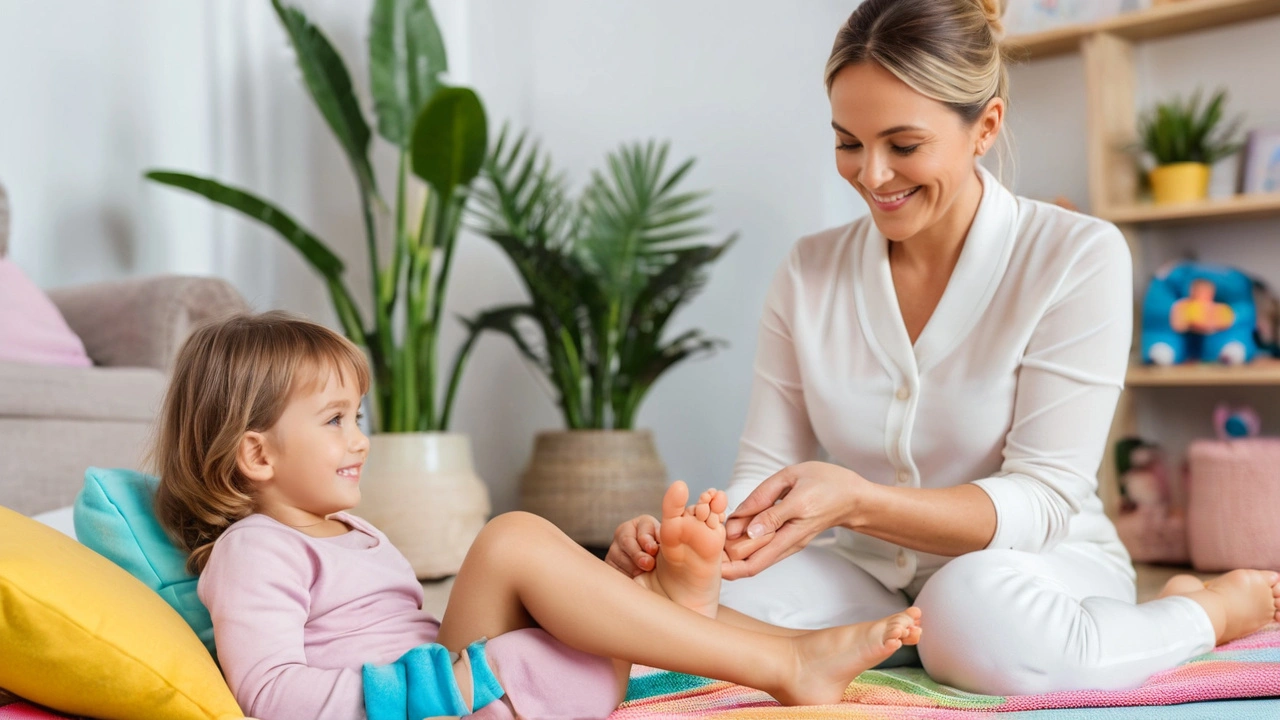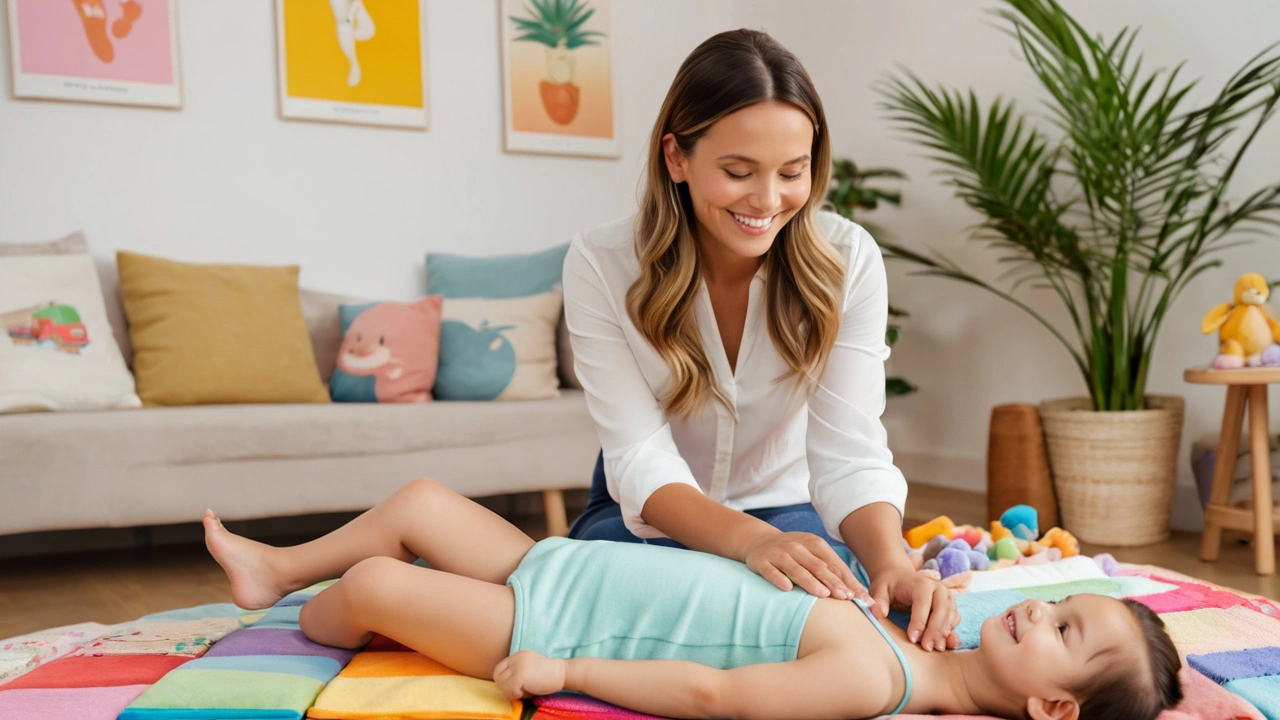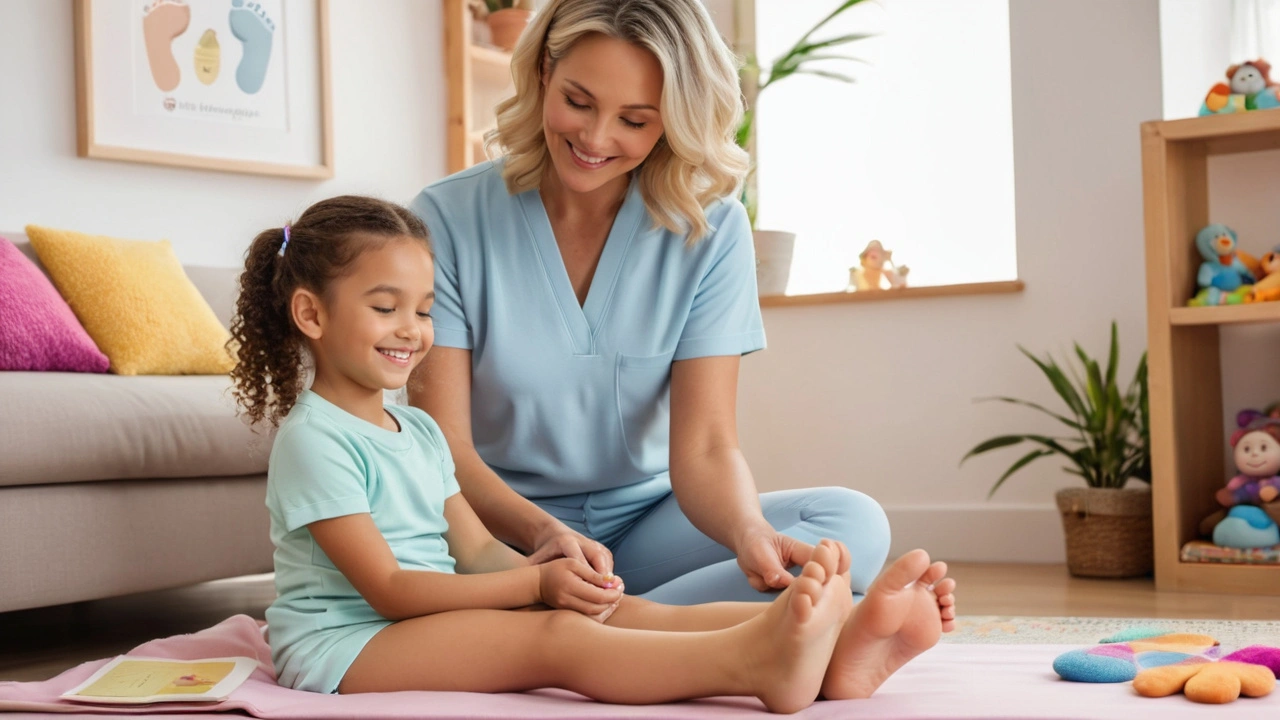Reflexology, an alternative therapy involving the application of pressure to specific points on the feet, hands, and ears, is a practice that many adults swear by. But when it comes to children, parents naturally wonder about its safety and effectiveness.
Is it a viable option for helping with stress, digestive issues, and other common childhood ailments? Understanding the basics and what experts say can help parents make informed decisions about incorporating reflexology into their children's wellness routines.
Let's delve into the world of reflexology for kids, exploring how it works, its benefits, any potential risks, and practical tips for parents interested in this gentle therapy.
- Introduction to Reflexology
- How Reflexology Works
- Benefits of Reflexology for Kids
- Potential Risks and Concerns
- Expert Opinions and Studies
- Tips for Parents
Introduction to Reflexology
Reflexology is an ancient practice that dates back to ancient Egypt and China. It's based on the idea that specific points on the feet, hands, and ears correspond to different parts of the body. By applying pressure to these points, practitioners believe they can promote relaxation, improve circulation, and support overall health. Reflexology has grown in popularity as a complementary therapy, offering a non-invasive way to address various health concerns.
The practice of reflexology involves a methodical process of stimulating the nerve endings found in the hands and feet. These nerve endings are connected to various organs and systems within the body. When pressure is applied to these points, it is believed to send signals to the brain, which then triggers the body's natural healing processes. While the scientific community continues to explore the exact mechanisms of reflexology, many people have reported significant benefits from regular sessions.
In the context of children's health, reflexology is gaining traction among parents who seek alternative or complementary therapies. Children may experience stress, anxiety, digestive issues, and minor aches just like adults do. Reflexology offers a gentle, holistic approach that can help alleviate these symptoms without the side effects associated with some medications. It's important to note that while reflexology should not replace traditional medical care, it can be a valuable addition to a child's wellness routine when used responsibly.
Historical Background
The roots of reflexology can be traced back to ancient civilizations. Historical texts from China, Egypt, and India include references to the practice of applying pressure to the feet as a method of healing. In modern times, the work of Dr. William Fitzgerald in the early 20th century brought reflexology into the contemporary spotlight. He developed the concept of "zone therapy," which laid the foundation for modern reflexology practices.
Over the years, reflexology has evolved and gained acceptance in various health and wellness circles. Today, it's commonly used as a complementary therapy alongside conventional treatments. Reflexologists often work in collaboration with healthcare providers to offer holistic care that addresses both the physical and emotional well-being of their clients.
How Reflexology is Practiced
During a reflexology session, the practitioner will typically begin by assessing the client's overall health and discussing any particular concerns or conditions. The client is usually seated or lying down comfortably, with shoes and socks removed. The practitioner then uses their hands to apply gentle pressure to specific points on the feet, hands, or ears. These points are mapped out in reflexology charts, which provide a visual guide for targeting different areas of the body.
Sessions can last anywhere from 30 minutes to an hour, depending on the client's needs and preferences. Many people find the experience to be deeply relaxing and report a sense of calm and well-being after a session. It's not uncommon for clients to fall asleep during their treatment, as the gentle pressure and soothing techniques can promote relaxation and stress relief.
One of the key benefits of reflexology is its non-invasive nature. It's a gentle therapy that can be suitable for people of all ages, including children. Practitioners may adjust their techniques to accommodate younger clients, ensuring a comfortable and positive experience. It's always advisable for parents to seek out a qualified and experienced reflexologist who has experience working with children.
"Reflexology has been a wonderful addition to our family's health routine. Our kids enjoy the sessions, and we’ve noticed improvements in their sleep and overall mood." - Sarah, a mother of two
How Reflexology Works
Reflexology is a therapeutic practice based on the principle that specific points on the feet, hands, and ears are linked to different organs and systems within the body. Practitioners believe that by applying gentle pressure to these reflex points, energy pathways are stimulated, promoting balance and healing in the corresponding areas.
This ancient technique has its roots in various cultures, including Egyptian and Chinese medicine. It wasn't until the early 20th century, however, that reflexology as we know it today began to take shape, thanks to the work of Dr. William Fitzgerald, an American ENT specialist. He mapped out what he called 'zone therapy,' which divided the body into ten vertical zones, each converging in specific points on the hands and feet.
The concept was further refined by reflexologists like Eunice Ingham, who developed detailed maps of the feet, indicating which areas corresponded to major organ systems. These maps are still widely used by practitioners today to target everything from digestive issues to stress and anxiety.
When working with children, reflexologists often use a much gentler touch than they might with adults. Kids are typically more sensitive, so the pressure is adjusted accordingly. Sessions may last between 30 minutes to an hour, depending on the child's age and specific needs.
Some parents report noticeable improvements after just a few sessions. These can include better sleep patterns, reduced anxiety, and improved digestion. For instance, rubbing the center of the toes is believed to help with sleep issues, while applying pressure to the outside edges of the feet can assist with respiratory conditions. Critics, however, question the scientific basis of reflexology, attributing observed benefits to the placebo effect.
"Reflexology taps into the body's own healing mechanisms, helping to promote overall well-being," says Dr. Laura Norman, a well-known reflexologist and author.
Several studies have attempted to measure the efficacy of reflexology. While results have been mixed, many point to its benefits in reducing pain and anxiety levels. For example, a 2011 study published in the Journal of Clinical Nursing found that reflexology significantly reduced pain and anxiety in patients undergoing cardiac surgery.
If you're considering reflexology for your child, it’s essential to consult a qualified practitioner who has experience working with children. Look for certifications from recognized bodies and check for any reviews or testimonials from other parents. This ensures that your child will receive safe and effective treatment tailored to their specific needs.
Some practitioners may even use visual aids and storytelling techniques to keep younger children engaged and comfortable during sessions. This not only makes the experience more enjoyable for the child but also helps to maximize the therapeutic benefits of reflexology.

Benefits of Reflexology for Kids
Many parents are exploring reflexology for kids as a way to support their children's health and well-being. This practice, which involves applying pressure to specific points on the feet, hands, and ears, can offer numerous benefits. One of the standout perks is its potential to help reduce stress and anxiety. In a world where children face increasing academic pressures and social challenges, reflexology can be a calming, grounding experience. It's natural for parents to worry about the mental health of their kids, and this gentle therapy offers a non-invasive way to bring a sense of peace and calm.
Another remarkable benefit is the alleviation of various physical ailments. Kids often suffer from digestive issues, headaches, and sleep disturbances. Reflexology has been found to offer relief from these common problems. By stimulating certain points on the feet that correspond to different organs and systems in the body, reflexology can promote better digestion, reduce the frequency and severity of headaches, and improve sleep patterns. This is a gentle, drug-free way to help children manage such issues, making it an appealing option for many parents.
Additionally, reflexology is known to boost circulation and the immune system. Children, especially those who are active, can benefit from enhanced circulation, which helps in the faster healing of minor injuries and cuts. A more robust immune system means that kids are less likely to fall ill frequently, which is especially important during cold and flu seasons. Reflexology supports the body's natural ability to heal and fend off illness, making it a valuable tool in maintaining good health.
Reflexology can also support emotional well-being. Children who experience emotional distress or mood swings may find solace in the relaxing and nurturing touch involved in reflexology sessions. As these sessions are often quiet and soothing, they provide an opportunity for kids to unwind and release pent-up stress. This can lead to improved mood and a greater sense of emotional balance, which is crucial for healthy development.
"Reflexology helps in reducing anxiety and improving the overall quality of life for kids. It’s a safe, natural method to address various physical and emotional issues they might face," says Dr. Jane Collins, a well-known pediatric reflexologist.
Moreover, reflexology sessions can be a bonding experience for parents and children. Spending time together in a calm, focused setting can strengthen the parent-child relationship. Parents can also learn basic reflexology techniques to practice at home, providing a valuable tool for supporting their child's health and creating moments of connection and care.
Finally, there's the simple fact that kids often enjoy the sensation of reflexology. Children can find the gentle pressure and massages on their feet or hands very soothing and pleasant. This makes it more likely that they'll participate willingly and enjoy the sessions, further enhancing the benefits of the therapy.
Potential Risks and Concerns
When considering reflexology for children, it is crucial for parents to be aware of any potential risks and concerns associated with this practice. While reflexology is generally regarded as a non-invasive and gentle therapy, certain factors must be taken into account, especially when dealing with children’s sensitive and developing bodies.
One of the primary concerns is the possibility of applying too much pressure. Kids have tender, growing tissues that can easily be bruised or strained if the person administering the reflexology is not well-versed in appropriate techniques for children. Therefore, it is important to ensure that any practitioner working with children is certified and experienced in pediatric reflexology.
Another consideration is the potential for adverse reactions. While these are rare, some children may experience temporary discomfort, increased sensitivity, or even emotional release during or after a session. In these cases, it's beneficial for parents to be present during the session to provide comfort and reinforce the child’s sense of security.
It is also essential to recognize that reflexology should not be used as a substitute for conventional medical care. For example, if a child has a serious health condition or chronic illness, reflexology can be an adjunct to, but not a replacement for, medical treatment. Consulting with a pediatrician before starting reflexology can ensure that it is a suitable and safe supplementary therapy.
Reflexologists caution against using this therapy on children with certain conditions. For instance, applying pressure to the feet of a child with a foot injury, infection, or a severe skeletal condition may cause further harm. Moreover, children with specific circulatory problems might need to avoid reflexology, especially if they are prone to blood clotting issues.
“While reflexology can offer significant benefits for children, it must be approached with careful consideration of specific medical needs and conditions. Consulting with healthcare providers ensures safe and effective integration of reflexology into the child's wellness plan,” says Dr. Elizabeth Turner, a pediatric specialist.
Parents should also approach reflexology with realistic expectations. Reflexology is not a cure-all and might not produce immediate results. It can, however, serve as a complementary therapy that supports the child’s overall well-being through relaxation and stress reduction. Patience and consistency are often key to seeing the full benefits.
For children with disabilities or special needs, reflexology should be tailored to meet their individual requirements. Practitioners may need to modify techniques and session lengths to avoid causing overstimulation or discomfort. Collaboration with caregivers and healthcare professionals is essential in these cases to ensure that the therapy is both effective and appropriate.
In summary, while reflexology can be a beneficial and safe practice for children, parents must be vigilant about choosing qualified practitioners and understanding the specific needs and limitations of their child. Communication with healthcare providers and careful monitoring of the child’s response to therapy are essential components of responsible reflexology practice.

Expert Opinions and Studies
The practice of reflexology has been the subject of numerous studies aimed at assessing its validity and effectiveness, especially in children. One of the first questions parents ask is whether it has been scientifically proven to be beneficial. Several experts in complementary medicine and child health have weighed in on the topic, providing valuable insights.
Dr. Mary Atkinson, a renowned pediatric reflexologist, shares, “When applied correctly, reflexology can serve as a non-invasive and safe therapy for children. It can help alleviate various common ailments like headaches, anxiety, and digestive problems.” Studies conducted by the National Institute of Health have shown that reflexology can be particularly effective in reducing pain and promoting relaxation in children who are undergoing medical treatments.
To delve deeper, a study published in the Journal of Pediatric Oncology Nursing found that reflexology significantly reduced nausea and anxiety in young cancer patients. The study involved a small sample size of 30 participants, making it one of the few clinical trials focused on reflexology for children. While the results are promising, researchers emphasized the need for larger-scale studies to firmly establish these benefits.
In another comprehensive review conducted by the University of Exeter, data from multiple studies were analyzed to understand the wider effects of reflexology on children’s health. According to their findings, reflexology can help improve sleep patterns, reduce stress levels, and enhance the overall well-being of children. However, the review also noted that the therapeutic benefits could vary based on the practitioner’s skill and the child’s specific health condition.
Anecdotal evidence from parents also supports the positive impact of reflexology. Numerous testimonials report improvements in children’s mood, sleep, and even concentration after undergoing reflexology sessions. While these personal accounts are not substitute for scientific research, they do highlight the potential benefits observed in real-life scenarios.
It's important for parents to seek certified practitioners who specialize in pediatric reflexology. Certification ensures that the practitioner has undergone rigorous training and understands the nuances involved in treating children. According to the Reflexology Association of America, qualified pediatric reflexologists employ gentle techniques tailored to the sensitivity of young clients.
Another aspect to consider is the ethical guidelines followed by practitioners. Ethical practices ensure the child's comfort and well-being during the sessions. The Association of Reflexologists provides guidelines on maintaining a safe, respectful, and child-friendly environment, which is crucial for effective therapy.
In summary, expert opinions and studies collectively hint at the promise reflexology holds for children. While ongoing research is necessary to solidify its scientific backing, current findings and practitioner insights suggest that reflexology can be a supportive complementary therapy for various childhood conditions. Parents should consult healthcare providers and certified reflexologists to make informed decisions tailored to their child's needs.
Tips for Parents
For parents considering reflexology for their children, there are several important tips to keep in mind. First and foremost, it's essential to consult with your pediatrician before beginning any new therapeutic regimen. Reflexology may not be suitable for every child, especially those with certain medical conditions or sensitivities. By discussing it with a healthcare professional, you can ensure that it won't interfere with any existing treatments or medications.
Choosing the right practitioner is also crucial. Look for a certified and experienced reflexologist who has specific training in working with children. You can often find reputable practitioners through associations such as the International Institute of Reflexology or local holistic health clinics. Reading reviews and seeking recommendations from other parents can offer valuable insights.
“When selecting a reflexologist for your child, make sure they are well-versed in pediatric care. Children's bodies are not the same as adults', and it requires a gentle, knowledgeable approach,” says Dr. Alice Thompson, a pediatrician and holistic health advocate.
Creating a comfortable and familiar environment can make the experience more enjoyable for your child. If possible, schedule sessions at a time when your child is typically calm and relaxed. Bringing along a favorite toy or blanket can help ease any anxiety. Communication with your child is key; explain what will happen during the session in a way they can understand, and encourage them to speak up if they feel uncomfortable at any point.
It's also a good idea to observe a session to ensure it aligns with your expectations. During observation, take note of the reflexologist's communication style and approach. Are they patient and respectful? Do they explain the process and respond to both your and your child's questions? A positive and transparent interaction is a good indicator that your child is in safe hands.
Consistency can play a significant role in the effectiveness of reflexology. Instead of one-off sessions, aim for a regular schedule that matches your child's needs. This allows the body to respond and adapt to the therapy more effectively. However, always monitor your child's reaction after each session. If you notice any adverse effects, such as increased irritability or unusual discomfort, consult with both the reflexologist and your healthcare provider.
Finally, consider integrating reflexology into a broader wellness routine. Combining it with other holistic practices such as mindful breathing exercises, a balanced diet, and adequate sleep can enhance the overall benefits. Remember, the goal is to support your child's natural ability to heal and thrive. Reflexology can be a gentle and supportive addition to your family's approach to health and wellness.

